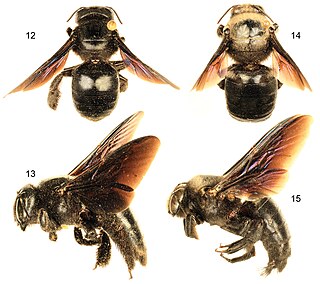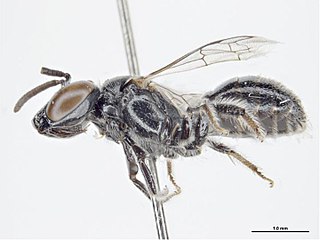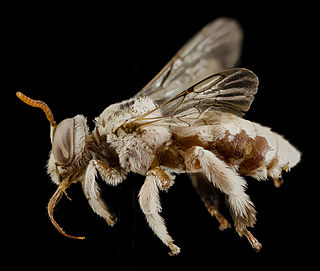
Apidae is the largest family within the superfamily Apoidea, containing at least 5700 species of bees. The family includes some of the most commonly seen bees, including bumblebees and honey bees, but also includes stingless bees, carpenter bees, orchid bees, cuckoo bees, and a number of other less widely known groups. Many are valuable pollinators in natural habitats and for agricultural crops.
Michael S. Engel, FLS, FRES is an American paleontologist and entomologist, notable for contributions to insect evolutionary biology and classification. In connection with his studies he has undertaken field expeditions in Central Asia, Asia Minor, the Levant, Arabia, eastern Africa, the high Arctic, and South and North America, and has published more than 925 papers in scientific journals.Some of Engel's research images were included in exhibitions on the aesthetic value of scientific imagery.

Corda is a settlement in the island of Santo Antão, Cape Verde. It is part of the municipality Ribeira Grande. It is situated in the mountainous interior of the island at about 1,000 meters elevation, 13 km north of the island capital Porto Novo. Corda consists of several villages, including Chã de Corda and Esponjeiro. The national road from Porto Novo to Ribeira Grande (EN1-SA01) passes through Corda. The crater of Cova lies 4 km to the southeast. Corda lies in the Cova-Paul-Ribeira da Torre Natural Park.

The Melectini are a tribe of medium- to large-sized cuckoo bees in the family Apidae, found essentially worldwide. They are brood parasites of the related typical digger bees (Anthophorini) and occasionally visit flowers.

Exaerete is a genus of euglossine bees found from Mexico to northern Argentina. Like all orchid bees, they are restricted to the Neotropics. All but one species is metallic green, and they are cleptoparasites in the nests of other euglossines in the genera Eufriesea and Eulaema. It contains the following species:

Thyreus is an Old World genus of bees, one of many that are commonly known as cuckoo bees, or cloak-and-dagger bees, and are kleptoparasites of other species of bees, mostly in the genus Amegilla. They all have strongly contrasting patterns of coloration – three species from the Sydney region, Thyreus nitidulus, T. lugubris, and T. caeruleopunctatus are bright blue and black.

Amegilla bombiformis, commonly known as the teddy bear bee or golden haired mortar bee, is an Australian native bee in the family Apidae.

The Rhathymini are a tribe of kleptoparasitic apid bees.

Thyreus lugubris, common name the domino cuckoo bee, is a species of Australian native bee belonging to the family Apidae, subfamily Apinae.
Thyreus ramosellus, is a species of bee belonging to the family Apidae subfamily Apinae.

Xylocopa aestuans, or Xylocopa (Koptortosoma) aestuans, is a species of carpenter bee. It is widely distributed in Southeast Asia.

The Oriental carpenter bee, Xylocopa nasalis, or Xylocopa (Biluna) nasalis, is a species of carpenter bee. It is widely distributed in Southeast Asian countries. It is a major pollinator within its ecosystem, and is often mistaken for a bumblebee. The species leads a solitary lifestyle with a highly female-biased colony in the nest.

Xylocopa sulcatipes is a large Arabian carpenter bee. These multivoltine bees take part in social nesting and cooperative nesting. They are metasocial carpenter bees that nest in thin dead branches. One or more cooperating females build many brood cells. They have been extensively studied in Saudi Arabia and Israel.

The wildlife of Saudi Arabia is substantial and varied. Saudi Arabia is a very large country forming the biggest part of the Arabian Peninsula. It has several geographic regions, each with a diversity of plants and animals adapted to their own particular habitats. The country has several extensive mountain ranges, deserts, highlands, steppes, hills, wadis, volcanic areas, lakes and over 1300 islands. The Saudi Arabian coastline has a combined length of 2,640 km (1,640 mi) and consists of the Gulf of Aqaba and the Red Sea to the west while a shorter eastern coastline can be found along the Persian Gulf.

Braunsapis is a genus of bees in the tribe Allodapini. It is the largest genus of the tribe and is known for its array of social behaviors. The genus is distributed in Africa, Asia, and Australasia.
Thyreus garouensis is a cleptoparasitic species of bee from Northern Cameroon in Central Africa. It belongs to the genus of Thyreus, whose members are often referred to as cuckoo bees, and to the family Apidae.

Thyreus denolli is an African species of kleptoparisitic bee. It belongs to the tribe Melectini and to the genus Thyreus, the members of which are often referred to as 'Cuckoo bees', due to their parasitic behaviour. It is one of the most distinctive Thyreus bees in Cape Verde.

The Arabian green bee-eater is a species of bird in the family Meropidae. It is found throughout arid regions of the Arabian Peninsula from Saudi Arabia south to Yemen and east to Oman and the United Arab Emirates, and has expanded its range north to the Levant over the past few decades.

The Tarsaliini are a tribe of apine bees. They are between 7-13mm long. As of 2015, it only contains its type genus, Tarsalia, which was considered part of the tribe Ancylaini until Engel split it in 2015, he believes the Tarsaliini are more closely related to the Eucerini than the Ancylaini. An Arabian and North African tribe, the Tarsaliini have been observed in Egypt, Sudan, Iran, and the Arabian Peninsula.
















